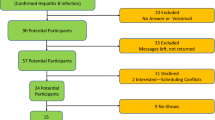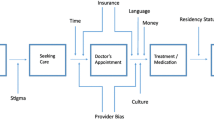Abstract
Worldwide, hepatocellular carcinoma (HCC) is the third leading cause of cancer deaths and the ninth in the US. Hepatitis B and C make up almost 80 % of HCC cases. Based on our Hepatitis Outreach Network screening program data, approximately 40 % of at-risk foreign-born community members who tested positive for viral hepatitis B and/or C did not follow up for additional care. Our aim was to use theory-driven qualitative research to identify barriers and facilitators to follow-up after viral hepatitis diagnosis among these community members from the viewpoint of primary care providers (PCPs). As viral hepatitis is a precursor of liver cancer, timely treatment of the virus has the potential to reduce the incidence and burden of liver cancer. We performed semi-structured key informant interviews with 20 primary care physicians who predominantly serve Korean, Chinese, Egyptian, and Russian communities. Barriers detected included cultural factors commonly seen amongst immigrant populations such as busy work schedules and non-English language. Common facilitators include increased primary care physician involvement and linkages to care within communities in which patients reside. Providers perceived that they are gatekeepers to specialty care for their patients and therefore key persons to engage in viral hepatitis evaluation and management by specialists. This initial study suggests that re-focusing energy into primary care physicians might offer promise for improved care for individuals from immigrant communities who have viral hepatitis to help them engage in care and thereby reduce the burden of liver cancer.

Similar content being viewed by others
References
Ferlay J, Bray F, Pisani P, Parkin DM (2001) GLOBOCAN 2000: cancer incidence, mortality and prevalence worldwide, version 1.0. International Agency for Research on Cancer, Cancer Base no. 5. IARC Press, Lyon
Surveillance, Epidemiology, and End Results (SEER) Program (2010) SEER*Stat database: incidence—SEER 9 Regs research data, Nov 2009 Sub (1973–2007). National Cancer Institute, Bethesda
World Health Organization, International Agency for Research on Cancer. GLOBOCAN 2008. (http://globocan.iarc.fr)
Perz JF, Armstrong GL, Farrington LA, Hutin YJ, Bell BP (2006) The contributions of hepatitis B virus and hepatitis C virus infections to cirrhosis and primary liver cancer worldwide. J Hepatol 45:529–538
IOM (2010) Hepatitis and liver cancer: a national strategy for prevention and control of hepatitis B and C. National Academies Press, Washington
Ward JW (2008) Time for renewed commitment to viral hepatitis prevention. Am J Public Health 98(5):779–781
Wang S (2009) Hepatitis B: summarizing gaps/potential solutions in insurance coverage and care for the uninsured, underinsured, and the poor. Presented at: Transforming Our Domestic Response to Hepatitis B & C; Washington, DC, 10–11 September
Grebely J, Raffa JD, Lai C et al (2009) Low uptake of treatment for hepatitis C virus infection in a large community-based study of inner city residents. J Viral Hepat 16(5):352–358
Trooskin SB, Navarro VJ, Winn RJ et al (2007) Hepatitis C risk assessment, testing and referral for treatment in urban primary care: role of race and ethnicity. World J Gastroenterol 13(7):1074–1078
Perumalswami PV, Factor SH, Kapelusznik L et al (2013) Hepatitis Outreach Network: a practical strategy for hepatitis screening with linkage to care in foreign born communities. J Hepatol 58:890-897
Aday LA, Andersen R (1974) A framework for the study of access to medical care. Health Serv Res 9(3):208–220
Airhihenbuwa CO (1995) Health and culture beyond the western paradigm. Sage Publications, Thousand Oaks
Airhihenbuwa CO (1999) Of culture and multiverse: renouncing “the Universal Truth” in health. J Health Educ 30:267–273
Kannan S, Webster D, Sparks A, Acker CM, Greene-Moton E, Tropiano E, Turner T (2009) Using a cultural framework to assess the nutrition influences in relation to birth outcomes among African American women of childbearing age: application of the PEN-3 theoretical model. Health Promot Pract 10(3):349–358
Ka’opua LSI, Park SH, Ward ME, Braun KL (2008) Developing a culturally responsive breast cancer screening promotion with Native Hawaiian women in churches. Health Soc Work 33(3):169–177
Heath H, Cowley S (2004) Developing a grounded theory approach: a comparison of Glaser and Strauss. Int J Nurs Stud 41(2):141–150
Glaser BG (1978) Theoretical sensitivity: advances in the methodology of grounded theory. Sociology Press, Mill Valley
Glaser BG (1992) Emergence vs. forcing: basics of grounded theory analysis. Sociology Press, Mill Valley (CA)
Glaser BG (1998) Doing grounded theory: issues and discussion. Sociology Press, Mill Valley
Glaser BG (1999) Keynote address for the fourth annual qualitative health research conference. Qual Health Res 9(6):836–845
Glaser BG, Strauss AL (1967) The discovery of grounded theory: strategies for qualitative research. Aldine Publishing Company, Hawthorne
Strauss A, Corbin J (1990) Basics of qualitative research: techniques and procedures of developing grounded theory. Sage Publications, London
Strauss A, Corbin J (1994) Grounded theory methodology. Sage Publications, Thousand Oaks
Strauss A, Corbin J (1998) Basics of qualitative research: grounded theory procedures and technique, 2nd edn. Sage, London
Treloar C, Newland J, Rance J, Hopwood M (2010) Uptake and delivery of hepatitis C treatment in opiate substitution treatment: perceptions of clients and health professionals. J Viral Hepat 17(12):839–844
Sherer R (1998) Adherence and antiretroviral therapy in injection drug users. JAMA 280:257–568
Swan D, Long J, Carr O et al (2010) Barriers to and facilitators of hepatitis C testing, management, and treatment among current and former injecting drug users: a qualitative exploration. AIDS Patient Care St 24(12):753–762
Wallace J, McNally S, Richmond J, Hajarizadeh B, Pitts M (2011) Managing chronic hepatitis B: a qualitative study exploring the perspectives of people living with chronic hepatitis B in Australia. BMC Res Notes 4(45):1–7
Herek GM et al (1998) Culturally sensitive AIDS educational videos for African American audiences: effects of source, message, receiver, and context. Am J Community Psychol 26(5):705–743
Kalichman SC et al (1993) Culturally tailored HIV-AIDS risk-reduction messages targeted to African-American urban women: impact on risk sensitization and risk reduction. J Consult Clin Psychol 61(2):291–295
Doll R, Stephen J, Barroetavena MC et al (2003) Patient navigation in cancer care: program delivery and research in British Columbia. Can Oncol Nurs J 13:193
Freeman HP (2004) A model patient navigation program. Oncol Issues 19(5):44–46
Wells K, Battaglia T, Dudley D, Garcia R et al (2008) Patient navigation: state of the art or is it a science? Cancer 113(8):1999–2010
Ryan GL et al (2001) Examining the boundaries of tailoring: the utility of tailoring versus targeting mammography interventions for two distinct populations. Health Educ Res 16(5):555–566
Acknowledgments and Disclosures
This project was supported by the American College of Gastroenterology and Tisch Cancer Institute. The authors would like to extend thanks to HONE’s community partners, the HONE and Mount Sinai Department of Oncological Sciences’ staff, and our study participants for their insight and support. In particular, the authors are grateful to Danielle Crookes and Karent Zorogastua, coordinators in the Department of Oncological Sciences.
Hyosun Han, Ponni Perumalswami, Lawrence Kleinman, and Lina Jandorf have no relevant financial disclosures.
Author information
Authors and Affiliations
Corresponding author
Rights and permissions
About this article
Cite this article
Han, H., Perumalswami, P.V., Kleinman, L.C. et al. Voices of Multi-ethnic Providers in NYC: Health Care for Viral Hepatitis to Prevent Hepatocellular Carcinoma. J Canc Educ 29, 214–223 (2014). https://doi.org/10.1007/s13187-013-0569-7
Published:
Issue Date:
DOI: https://doi.org/10.1007/s13187-013-0569-7




